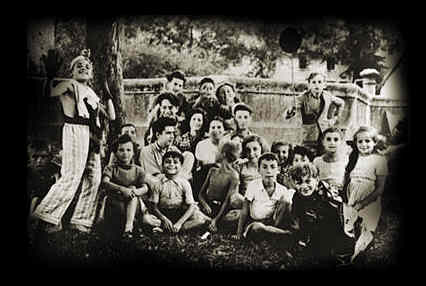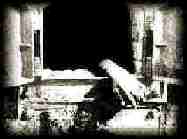






In 1944 the Nazis from Lyon sent two vans to the French village of Izieu. Their Mission: to exterminate the children of an orphanage known as La Maison d'Izieu.
The sleepy village of Izieu lay overlooking the Rhone river between Lyon and Chambery in central France. Refugees from Herault were the first arrivals at the Children's home and their Jewish identity was kept secret by the staff. The children, aged between four and seventeen, felt safe and secure, supervised by seven adults. Often one of the young boys entertained his companions by making movies, paintings on transparent paper and scrolled past a lighted box.

However, on the morning of April 6, 1944, as they all settled down in the refectory to drink hot chocolate, three vehicles, two of which were lorries, pulled up in front of the home. The Gestapo, led by the 'Butcher of Lyon' Klaus Barbie, entered the home and forcibly removed the forty four children and their seven supervisors, throwing the crying and terrified children on to the trucks like sacks of potatoes.
As a witness later recalled: 'I was on my way down the stairs when my sister shouted to me: it's the Germans, save yourself! I jumped out the window. I hid myself in a bush in the garden. I heard the cries of the children that were being kidnapped and I heard the shouts of the Nazis who were carrying them away...'
Following the raid on their home in Izieu, the children were shipped directly to the 'collection center' in Drancy, then put on the first available train towards the deathcamps in the East. Forty-two children and five adults were gassed in the extermination camp of Auschwitz. Two of the oldest children and Miron Zlatin, the superintendent, ended up in Tallin in Estonia and were put to death by a firing squad.



Of the forty-four children kidnapped by the Nazis in Izieu, not a single one survived. Of the supervisors there was one sole survivor, twenty-seven year old Lea Feldblum. When the children from Izieu arrived in Auschwitz on April 15, 1944, Léa led the column of children to the selection point. When she informed the SS that these children were from a home, she was ruthlessly separated from them and sent to the prisoners' camp.
One survivor of Auschwitz revealed during Klaus Barbie's trial what happened to the children: 'I asked myself where were the children who arrived with us? In the camp there wasn't a single child to be seen. Then those who had been there for a while informed us of the reality. 'You see that chimney, the one smoke never stops coming out of .. you smell that odor of burned flesh ...'

One of the children of La Maison d'Izieu was eleven-year-old Liliane Gerenstein, who was being sheltered in the orphanage in the hope that the Nazi Gestapo would not find her. Lilliane and her brother were sent to their deaths a few days after she wrote this letter to God:
God?
How good You are, how kind and if one had to count the number of
goodnesses and kindnesses You have done, one would never finish.
God? It is You who command. It is You who are justice, it is You who reward the
good and punish the evil.
God? It is thanks to You that I had a beautiful life before, that I was
spoiled,
that I had lovely things that others do not have.
God? After that, I ask You one thing only: Make my parents come back, my poor
parents protect them (even more than You protect me) so that I can see
them again as soon as possible.
Make them come back again. Ah! I had such a good mother and such a good
father! I have such faith in You and I thank You in advance.
The children's father, Chapse, miraculously survived the Holocaust and
emigrated to the United States.
After the Nazi raid Klaus Barbie sent a telex to Gestapo headquarters in Paris declaring that the children's colony at Izieu had been removed and arrangements made for the deportation of its residents. The full text, which contains mistakes about the children's ages and apparently counted three of the oldest children among the adults arrested, reads:
"This morning, the Jewish children's home, Children's Colony, at Izieu has been removed. 41 children in all, aged 3 to 13, have been captured. Beyond that, the arrest of all the Jewish personnel has taken place, namely 10 individuals, among them 5 women. It was not possible to secure any money or other valuables. Transportation to Drancy will take place on 4/7/44. Signed Klaus Barbie."

|
|
|
sources:
Beate and Serge Klarsfeld
U.S. Holocaust Memorial Museum
Letter from Izieu By Raphael Rothstein
The Children of Izieu: A Jewish Tragedy by Serge Klarsfeld
French Children of the Holocaust A Memorial by Serge Klarsfeld
Musee Memorial des Enfants d’Izieu (Memorial Museum of the Children of Izieu)